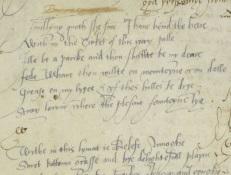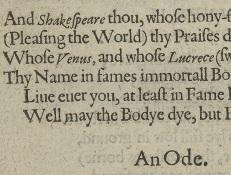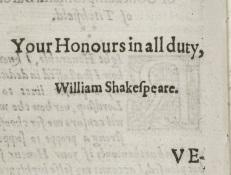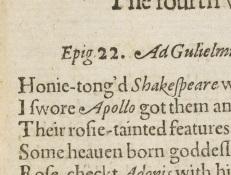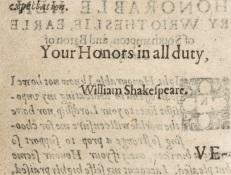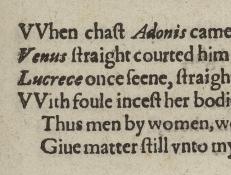To view a sortable list, please visit the Resource
All Documents
June 25, 1596
On June 25, 1596, the London printer and publisher John Harrison the Elder transferred his rights to print Shakespeare's poem Venus and Adonis to his colleague, William Leake, who printed the fifth edition in 1599.
1596
The fourth edition of Shakespeare's popular narrative poem Venus and Adonis was published in 1596, three years after the first edition. This fourth edition was the last to be printed by Richard Field and sold by John Harrison.
ca. 1596
Henry Colling, who attended Cambridge but left without a degree in the early 1580s, transcribed two stanzas of Venus and Adonis into this small folio of historical tracts (lines 229&ndas
1598
In “A Remembrance of some English Poets,” the poet Richard Barnfield praises Edmund Spenser, Samuel Daniel, Michael Drayton, and Shakespeare.
ca. 1598
The scholar and writer Gabriel Harvey was known and mocked in his lifetime for making copious notes in the margins of printed books. An inventor of words, friend of Edmund Spenser, and rival of Thomas Nashe, he constantly sought to improve himself through note-taking and repetitive reading.
1599
This 1599 printing is the only surviving copy of the sixth edition of Venus and Adonis, first published in 1593.
1599
John Weever’s Epigrammes in the oldest cut, and newest fashion was published in 1599. Weever began his career as an aspiring poet and literary observer at Cambridge, where he was the student of William Covell at Queen’s College.
1599
The fifth edition of Shakespeare’s perennially popular poem Venus and Adonis appeared in 1599.
1600
Not all contemporary allusions to Shakespeare were positive. In the second stanza of Tom-Tel Troths Message (1600), John Lane commands his pen to “In mournfull verse lament the faults of men,” particularly in England.
1600
Like other plays from the period, Shakespeare's plays were meant to be read both as stories and as sources for sententiae, or memorable aphorisms.



